I was able to make a lot of progress today on the piece I started yesterday. I made so much progress, I’m 2/3 of the way through. So I’d like to think that I’ll get it off the loom tomorrow, but who knows, life keeps taking all sorts of twists and turns…
I’ll describe how I did the piece, if you aren’t a handweaver and are reading this, it will go right over your head I’m sure, but bear with me, I always get really interested people whenever I lecture on the Theo Moorman technique, and I’m doing this a slightly different way, with a pick-up. First the draft:
![]()
I am threading the first and second shaft with gray 10/2 cotton, and shafts three and four are threaded with gray polyester sewing thread. So the ground fabric is a plain weave with shafts one and two, and the thin tie-down threads are on shafts three and four.
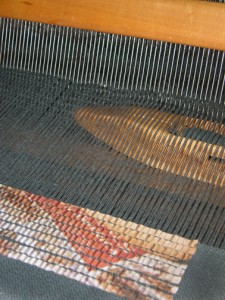 First I lift shaft 1 and 3, and weave across with the 10/2 cotton in the shuttle.
First I lift shaft 1 and 3, and weave across with the 10/2 cotton in the shuttle.
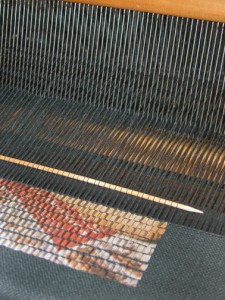 Then I drop shaft one, and insert a pick-up stick, which is an 1/8″ dowel that I shaved the ends on to make it pointy. The pick-up stick goes under the threads on shaft 3, the sewing thread, picking up only the threads I want to hold up through the next four rows. That way, the tie-down threads will weave into the background on the sides where the silk strips won’t be woven in. I release shaft 3.
Then I drop shaft one, and insert a pick-up stick, which is an 1/8″ dowel that I shaved the ends on to make it pointy. The pick-up stick goes under the threads on shaft 3, the sewing thread, picking up only the threads I want to hold up through the next four rows. That way, the tie-down threads will weave into the background on the sides where the silk strips won’t be woven in. I release shaft 3.
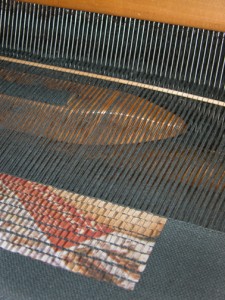 I lift shafts 2 and 4, and before I weave the next shot, I push the pick-up stick up against the reed. That lifts the tie-down threads from shaft 3 up and keeps them out of the way. I weave across with my cotton weft. I beat the weft in place, which moves the pick-up stick back to the fell line (last row of weaving) and then release shafts 2 and 4.
I lift shafts 2 and 4, and before I weave the next shot, I push the pick-up stick up against the reed. That lifts the tie-down threads from shaft 3 up and keeps them out of the way. I weave across with my cotton weft. I beat the weft in place, which moves the pick-up stick back to the fell line (last row of weaving) and then release shafts 2 and 4.
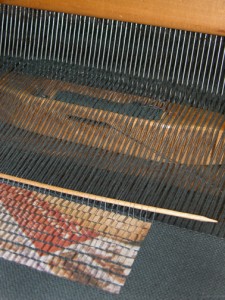
I lift shafts 1 and 3, and weave a shot of weft across, the pick-up stick remains at the fell line.
Then I repeat the previous step, lifting shafts 2 and 4, pushing the pickup stick against the reed, weave a shot of weft, and beat into place. The pick-up stick moves back to the fell line.
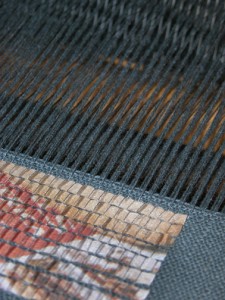 One more shot of weft, with shafts 1 and 3 lifted, for a total of five shots, it is important to weave an odd number of shots, once the strip is placed, the next row will raise the opposite set of tie-down threads.
One more shot of weft, with shafts 1 and 3 lifted, for a total of five shots, it is important to weave an odd number of shots, once the strip is placed, the next row will raise the opposite set of tie-down threads.
The piece should look like this, remove the pick up stick, and lower shaft 1. All that remains raised, are the tie-down threads on shaft 3.
I carefully take my silk strip (see the blog from yesterday for information on this part of the story), and place it under the raised tie-down threads.
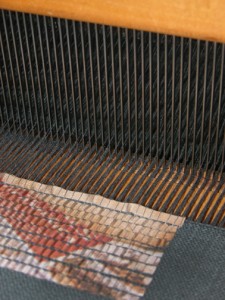 I beat that strip gently into place, and change the shed to raise shafts 2 and 4, and start the process all over again, but this time shafts 2 and 4 lead, with the pick-up stick placed under the tie-down threads on shaft 4. You eventually get into a rhythm.
I beat that strip gently into place, and change the shed to raise shafts 2 and 4, and start the process all over again, but this time shafts 2 and 4 lead, with the pick-up stick placed under the tie-down threads on shaft 4. You eventually get into a rhythm.
I could really use a boat shuttle with a lower profile, I’ve seen them around, made for the Structo Looms I think. My weaving buddy Sally had a couple at a meeting once, and I thought they would make weaving on a table loom so much more efficient. But for now, since I mostly do yardage on large floor looms, this is what I have to work with and I just scoot it across the shallow shed, until it gets to the other side. If I wanted speed, I’d use the floor loom. An advantage of the table loom is that shafts stay up by themselves while you are manipulating the silk strip. Speed isn’t so important here.
It is late and bedtime is looking like a pretty great concept…
I’m fascinated. Do you warp your tie down thread on a separate warp beam? What sewing thread do you use? Can’t wait to read your monograph on the subject. Nancy
Takako Ueki of HABU sells lovely shuttles in 3 sizes. They are light and low, perfect for fine weft. I’ll try to remember to bring one to JHW.
Nancy, it all depends on the length of the piece I am working on. I’ve done yardage this way, and I have put the tie-down threads on a second beam. With the smaller artworks, I would be cutting them off the loom before the tension differential became problematic. And it is easy to slip in a weighted bar from the warp beam to create additional tension on the sewing thread if I needed it. I am using Gutterman, but any long staple polyester would work here. I like the Gutterman because I can get it on 1000 m spools, and… Read more »
Jenny, thanks for the tip, can you bring them to the April meeting? I’ll miss the March one because I’ll be in California! I might even run into Takako while I’m there, I usually see her at all the conferences in the vendor halls. Course I could just drive the 25 minutes into NYC and go to HABU…
RE: Small shuttles: low profile, closed-bottom boat…
-Guildmate Betty Mills impressed us with one Halcyon currently sells.
-Glimaka vendor (MT-based) http://www.glimakrausa.com has one for about $35.
-Also, the smaller Swedish damask-type shuttles (with the bowed area for the bobbin) work well in small shed looms.
When shopping around for small shuttles, note if the shuttle you are considering will take a regular bobbin or if you have to wind a paper-bobbin base. (For speed and ease, I prefer ones that take a regular bobbin.)
Oh goody, this will give me something to shop for at all the conferences I will be attending this summer…
[…] I keep warped with a Theo Moorman 10/2 cotton structure, for my art pieces. I just finished the Big Sister piece, and I had originally needed the 12 dent reed for that one, but settled on a 6 dent reed, […]